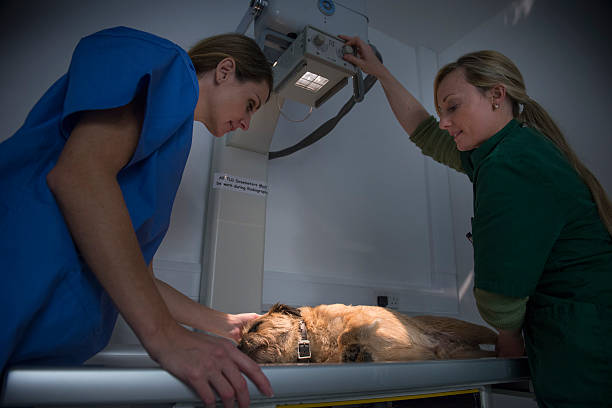Treating collapsing trachea in dogs: A vet's guide
Everything you need to know about collapsed trachea in dogs, including how to spot symptoms and the treatment options available.

Treating collapsing trachea in dogs can be a daunting prospect for owners. Tracheal collapse occurs when the windpipe becomes flattened and the airflow in and out of the lungs is obstructed. The rings of cartilage that support the windpipe lose their strength and become floppy and weak. Gradually the condition will get worse as the windpipe keeps getting flatter. Factors such as genetics, age, injuries, allergies, and diet are thought to contribute to its development.
In this article, I will explain what tracheal collapse is, what symptoms to look out for, and the treatment options available. I'm a practicing vet with over 13 years of experience in small animal surgery and medicine, and have been a dog owner my entire life.
What is a collapsing trachea in dogs?
Your dog's trachea, or windpipe as it is commonly known, is a vital part of their respiratory system. It carries air from the mouth and nose all the way to the lungs. It is made up of rings of cartilage that form a tube-like structure. The cartilage helps to hold the trachea open and prevent it from collapsing.
A collapsing trachea is a chronic medical condition that affects the windpipe. The supporting cartilage becomes weakened and the trachea flattens and collapses on itself, especially when your dog is breathing in.
The airflow in and out of the lungs is obstructed, leading to clinical signs associated with the condition. These include wheezing, coughing, and breathing difficulties. Dogs will often let out a characteristic dry harsh cough that is frequently described as a ‘goose honking’.
Tracheal collapse is more commonly seen in toy and miniature breeds of dogs, according to MSD Vet Manual. Tracheal collapse can be classified into different grades depending on the severity of the condition. Grade 1 is considered to be mild, with 25% collapse experienced, whereas Grade 4 is severe with 100% collapse present.
Symptoms of tracheal collapse in dogs
It is important for owners to be able to identify the symptoms of tracheal collapse. Symptoms can be tricky to spot in the early stages. Some of the signs are very subtle and as the condition gets worse, they may become more obvious.
Get the best advice, tips and top tech for your beloved Pets
The first sign owners will usually report is coughing fits. The coughing is often exacerbated by exercise, eating and drinking, and anxiety or excitement.
Typical clinical signs include:
- Coughing
- Heavy/ fast breathing
- Wheezing/whistling when breathing
- Lethargy in dogs
- Exercise intolerance
- Fainting episodes
- Blue tinge to gums (cyanosis)
If you see any of these symptoms at home or out and about with your dog, it is very important to take them to your vet to have them checked out.

How to treat tracheal collapse in dogs
Diagnosis is made by performing a thorough clinical exam initially. Your vet will assess your dog for signs of respiratory issues such as breathing difficulties, wheezing, and coughing. They will feel your dog’s trachea to try and identify any abnormalities.
Further diagnostic tests such as chest x-rays and examination of the trachea using an endoscope are often carried out. In some cases, fluoroscopy is used which is a type of x-ray that allows for real-time moving images of the trachea to be taken while your dog breaths in and out. Other tests to rule out other conditions such as heart disease or parasites may be carried out too depending on the case.
Once a diagnosis is made, the tracheal collapse is then given a grade. Treatment will be determined by the severity of clinical signs present and any other underlying health issues your dog has.
Mild cases are usually treated with medications. These can include:
- Cough suppressants: These help by reducing inflammation and irritation from coughing.
- Bronchodilators: These can be used to open up the airways to allow more oxygen in. They may also be useful in clearing mucous and helping the diaphragm contract. These can be given in pill form or inhaled.
- Corticosteroids: These have strong anti-inflammatory properties. They are often used to reduce inflammation in the airways. They can be given in pill form or inhaled.

It is important to note that these medications are very useful in managing the symptoms of tracheal collapse and improving your furry friend’s quality of life. However, none of them will cure the disease.
More severe cases will require surgical management. Your vet may decide to perform surgery where a stent is inserted into the airway. This acts to prop the airway open and prevent it from collapsing. Another option is to reinforce the trachea from the outside by placing plastic rings around it.
There are plenty of things owners can do at home to help their canine companions:
- Use the best dog harness instead of a collar to prevent too much pressure from being put on your dog's windpipe.
- Ensure your dog does not put on excess weight. If they are overweight, speak to your vet about safely reducing their calorie intake.
- Never smoke around your pet.
- Make sure your home is always well-ventilated

It is important to remember that you must seek vet attention straight away if you see any signs of tracheal collapse. If the condition is left untreated, it can get worse over time causing serious complications for your doggo.
Dogs with untreated tracheal collapse are often subject to weight loss, exercise intolerance, respiratory distress, and heart failure.
Are dogs with collapsed trachea suffering?
Sadly dogs with tracheal collapse can experience significant suffering. Breathing difficulties, exercise intolerance, and chronic coughing can all have a negative impact on their quality of life. The good news is, that with good management, they can go on to have a normal life expectancy.
Tracheal collapse itself does not usually shorten a dog’s lifespan, and if dogs receive prompt treatment they can have an acceptable quality of life. This is why it is so important to consult your vet if you are worried your dog has tracheal collapse. Early diagnosis is a key factor to help manage the condition and improve your furry friends well being.
You might also want to read: Why is my dog coughing?
Emma Chandley is a vet with 14 years of experience and has a keen interest in surgery. After graduating from the Royal Vet College in London in 2011, she achieved a postgraduate certificate in small animal surgery from the British Small Animal Veterinary Association and Nottingham Trent University. She was then awarded advanced practitioner status in the same discipline by The Royal College of Veterinary Surgeons. She has a black Labrador and two pygmy goats at home.

